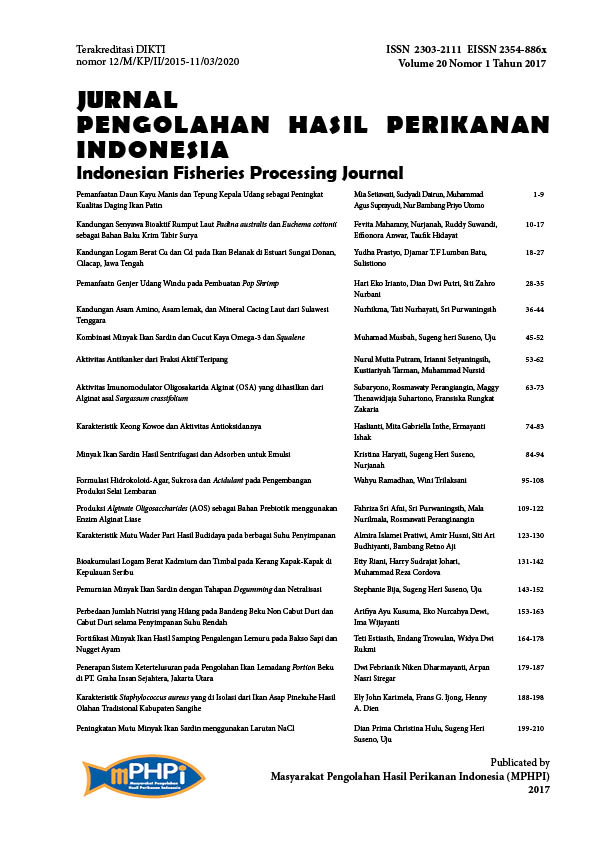Characteristics of Staphylococcus aureus Isolated Smoked Fish Pinekuhe from Traditionally Processed from Sangihe District
Abstract
Pinekuhe is the local name for smoked scad fish (Decapterus sp.), a traditionally processed fish product from Sangihe Islands whose taste, aroma and form are typical and unique. In this research aims of physiological and biochemical characteristics with pathogenicity isolated S. aureus which the isolated from the product smoked scad fish (Decapterus rusellii) Pinekuhe it was produce and prepared by the local fisherman in Sangihe Island Regency. The isolated that have gathered from this researched was 111 product isolate from the smoke fish Pinekuhe which grown from media MSA. Its had isolated already through the
test of physiological comprise, Gram staining and from the test of biochemical e.g., from the test Catalase, Voges-Proskauer, and Fermentation carbohydrate tests (Glucose and Manitol). The characteristics of pathogenicity S. aureus had been done and used by making of Coagulase, Nuklease Thermostabil production
and deoksiribonuklease (DNase). The result of this research showing that had still 111 isolating strains that still ingroup which consists of 108 isolated Staphylococcus and from 108 strains to 68 strains that had been test in identifying, as of Staphylococcus aureus with characteristics of Gram positif coccus, catalase positif,
Voges-Proskauer positif, and to Fermentation Glucose and Manitol. The 68 isolate S. aureus that characterize from Phatogen principles product Coagulase test, Nuklease Thermostabil and deoksiribonuklease (DNase). S. aureus is dominant (62%) contaminate smoked fish Pinekuhe processed traditional of Sangihe island.
test of physiological comprise, Gram staining and from the test of biochemical e.g., from the test Catalase, Voges-Proskauer, and Fermentation carbohydrate tests (Glucose and Manitol). The characteristics of pathogenicity S. aureus had been done and used by making of Coagulase, Nuklease Thermostabil production
and deoksiribonuklease (DNase). The result of this research showing that had still 111 isolating strains that still ingroup which consists of 108 isolated Staphylococcus and from 108 strains to 68 strains that had been test in identifying, as of Staphylococcus aureus with characteristics of Gram positif coccus, catalase positif,
Voges-Proskauer positif, and to Fermentation Glucose and Manitol. The 68 isolate S. aureus that characterize from Phatogen principles product Coagulase test, Nuklease Thermostabil and deoksiribonuklease (DNase). S. aureus is dominant (62%) contaminate smoked fish Pinekuhe processed traditional of Sangihe island.
Authors
KarimelaE. J., IjongF. G., & DienH. A. (2017). Characteristics of Staphylococcus aureus Isolated Smoked Fish Pinekuhe from Traditionally Processed from Sangihe District. Jurnal Pengolahan Hasil Perikanan Indonesia, 20(1), 188-198. https://doi.org/10.17844/jphpi.v20i1.16506
Authors who publish with this journal agree to the following terms:
- Authors retain copyright and grant the journal right of first publication with the work simultaneously licensed under a Creative Commons Attribution License that allows others to share the work with an acknowledgement of the work's authorship and initial publication in this journal.
- Authors are able to enter into separate, additional contractual arrangements for the non-exclusive distribution of the journal's published version of the work (e.g., post it to an institutional repository or publish it in a book), with an acknowledgement of its initial publication in this journal.





